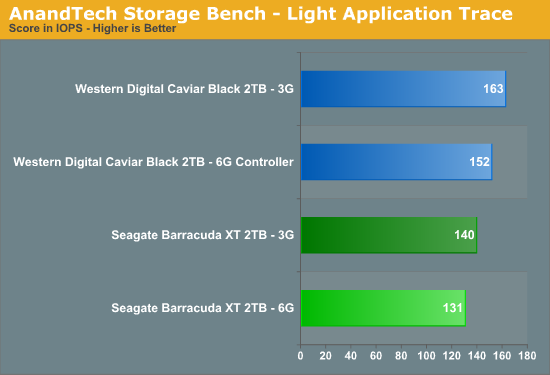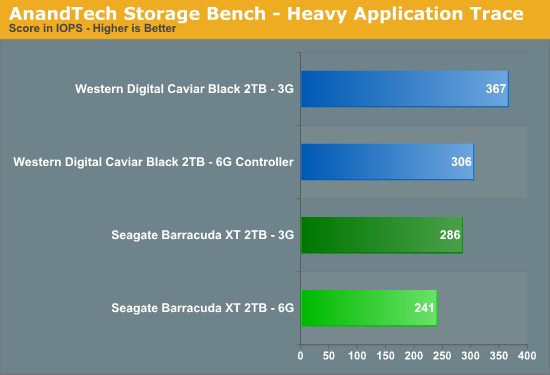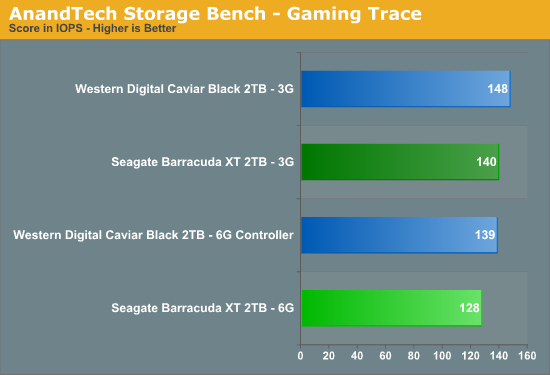Seagate Barracuda XT 2TB: SATA 6Gb/s Performance Preview
by Gary Key on October 29, 2009 12:00 AM EST- Posted in
- Storage
AnandTech Storage Bench Results –
Finding good, real world, storage benchmarks is next to impossible. The synthetic tests work up to a certain point but you need real world examples. Measuring performance in individual applications often ends up with charts like these where all of the drives perform identically. Benchmark suites like PCMark Vantage are the best we can do, but they are a bit too easy on these drives in my opinion and while representative of a real world environment, they aren’t necessarily representative of all real world environments.
Recently we’ve been able to get our hands on a piece of software that allows us to record all disk activity on a machine and then play it back on any other machine. The point is that we can now model a real world usage scenario without waiting for BAPCo or Futuremark to do it for us. The performance results are reported in I/O Operations per Second (IOPS).
The first in our new benchmark suite is a light usage application case. The Windows 7 system is loaded with Firefox, Office 2007 and Adobe Reader among other applications. With Firefox we browse web pages like Facebook, AnandTech, Digg and other sites. Outlook is also running and we use it to check emails, create and send a message with a PDF attachment. Adobe Reader is used to view some PDFs. Excel 2007 is used to create a spreadsheet, graphs and save the document. The same goes for Word 2007. We open and step through a presentation in PowerPoint 2007 received as an email attachment before saving it to the desktop. Finally we watch a bit of a Firefly episode in Windows Media Player 11.
There’s some level of multitasking going on here but it’s not unreasonable by any means. Generally the application tasks proceed linearly, with the exception of things like web browsing which may happen in between one of the other tasks.
The recording is played back on all of our drives here today. Remember that we’re isolating disk performance; all we’re doing is playing back every single disk access that happened in that ~5 minute period of usage. The light trace is composed of 37,501 reads and 20,268 writes. Over 30% of the IOs are 4KB, 11% are 16KB, 22% are 32KB and approximately 13% are 64KB in size. Less than 30% of the operations are absolutely sequential in nature. Average queue depth is 6.09 IOs.

The Marvell controller is 7% slower than the Intel controller with the WD drive and once again 7% with the Seagate drive. The WD drive is up to 24% faster than the Seagate drive depending on the controller configuration.
If there’s a light usage case there’s bound to be a heavy one. In this test we have Microsoft Security Essentials running in the background with real time virus scanning enabled. We also perform a quick scan in the middle of the test. Firefox, Outlook, Excel, Word and Powerpoint are all used the same as they were in the light test. We add Photoshop CS4 to the mix, opening a bunch of 12MP images, editing them, then saving them as highly compressed JPGs for web publishing. Windows 7’s picture viewer is used to view a bunch of pictures on the hard drive.
We then use 7-zip to create and extract .7z archives. Downloading is also prominently featured in our heavy test; we download large files from the Internet during portions of the benchmark, as well as use uTorrent to grab a couple of torrents. Some of the applications in use are installed during the benchmark, Windows updates are also installed. Towards the end of the test we launch World of Warcraft, play for a few minutes, then delete the folder. This test also takes into account all of the disk accesses that happen while the OS is booting.
The benchmark is 22 minutes long and it consists of 128,895 read operations and 72,411 write operations. Roughly 44% of all IOs were sequential. Approximately 30% of all accesses were 4KB in size, 12% were 16KB in size, 14% were 32KB and 20% were 64KB. Average queue depth was 3.59.

The Marvell controller is 19% slower than the Intel controller with the WD drive and 18% with the Seagate drive. The WD drive is up to 28% faster than the Seagate drive.
Our final test focuses on actual gameplay in four 3D games: World of Warcraft, Batman: Arkham Asylum, FarCry 2 and Risen, in that order. The games are launched and played, altogether for a total of just under 30 minutes. The benchmark measures game load time, level load time, disk accesses from saved games and normal data streaming during game play.
The gaming trace is made up of 75,206 read operations and only 4,592 write operations. Only 20% of the accesses are 4KB in size, nearly 40% are 64KB and 20% are 32KB. A whopping 69% of the IOs are sequential, meaning this is predominantly a sequential read benchmark. The average queue depth is 7.76 IOs.

Not much else to say here, the Marvell controller is 6% slower than the Intel controller with the WD drive and 9% with the Seagate drive. The WD drive is up to 8% faster than the Seagate drive.










55 Comments
View All Comments
Zak - Thursday, October 29, 2009 - link
Yeah, with port multiplier enclosures data from several drives is transferred over single SATA link. I had port multiplier 4-drive enclosures and with 4 hard drives in RAID0 I was easily maxing out the SATA3Gbps bandwidth.Z.
chrnochime - Thursday, October 29, 2009 - link
300 USD for the Premium Asus board as compared to ~170 for a P7P55D pro version just to have 6GB Sata and USB 3.0? That's a steep price to pay for just these two features.chrnochime - Thursday, October 29, 2009 - link
and it's 6Gb not GB whoops.Affectionate-Bed-980 - Thursday, October 29, 2009 - link
I hate seeing AT falling into the realm of previews. We seem to get more and more of these. Each preview promises followup reviews, but I see less and less follow up reviews or flat out full reviews. Remember when AT reviewed the WD 640gb Blue and the 7200.8s, 7200.10s, all that? Those were nice solid reviews. Now we get previews. Core i7 preview into OCing. No OCing guide today. The only motherboard roundup we got was the 3 or 4 motherboards we had at the i7 launch, while Toms spent 3 or 4 articles doing separate groups of roundups (enthusiasts, midrange, budget X58). I hate THG, and I always respected AT's opinion more, but when we're getting more and more half-assed reviews that are barely finished that DEPEND on follow-ups that aren't always done, then I have a problem.I'd rather see a solid review and be done with it. I'm glad we got a WD 2TB Black, but are you guys going to review that? AT is definitely leading the charge into the SSD world, but as we're doing it, we're forgetting a lot of nice new drives like the WD 2TB Black that I feel deserves a full review. Same with the new Seagate 7200.12s.
Zool - Thursday, October 29, 2009 - link
I think that people dont buy 2TB drives for speed. If u hawe TB-s data that u need to store its the only choice. With those read speeds u could watch fine a 500 Mbit video stream. Actualy with 64bit around for years you could have a 32GB system with for example 24GB ram disk. And ram disk working with intesive read write workload is like 100 times faster than the best ssd. But its actualy rare to have 4+ GB memory still. I think that the storage will be in future in levels like CPU cache. L1 storage smaller for used data and L2 for storage of large data. Or even a ram level (actualy cpu memmory should be divided in levels long ago, buying 32GB of very fast memmory is overkill.U could hawe 2GB realy fast memory and a very cheap 32GB memory which is still much faster than anything else)Everyone who can use brain already know that 6Gb/s sata is just a marketing buzz unless u use a giant raid.
Zak - Thursday, October 29, 2009 - link
Actually, as I went up to 1TB and larger drives I started wishing for more speed too. I use 1.5TB and 2TB disks as backups and mirrors and full backups of terabytes of files take a long time:)Zool - Friday, October 30, 2009 - link
You need to be patient. It wont change any time soon. Even with ssd speeds backup TB-s of data takes hours.Hint: Dont backup that often :)
Maybe there are some programs that monitor only files that were changed and only backup those, not the whole drive. If u want backup that often.
yyrkoon - Thursday, October 29, 2009 - link
Like another user has already mentioned, there is port multiplier technology, which is about the only thing that can use this additional bandwidth _right_now_ . Even then, the drives must be in some form of RAID, and if for performance, you're still going to see access time "doubling".The point here would be I think if people cared that much about performance, they would opt for at minimum an inexpensive SSD that performs decent for a SSD, and completely destroys any mechanical drive. This is not to say that I think your tests are null and void. This *IS* to say that I think that people are going to be more worried about reliability concerning these drives, not so much about performance as long as the performance is close to something reasonable for the technology. I think both drives in this test have demonstrated this level of performance.
Now if you guys really want to impress us mere mortals with numbers, let us see you guys at Anandtech put two iSCSI targets with 32GB of ramdisk each out to a single initiator as a RAID 0 array. Then watch how the drive visible on the initiator smokes all of your tests ;)
Wait until Starwind implements "true" RAID 0 over multiple links the correct way, and it will be even "funner".
Griswold - Thursday, October 29, 2009 - link
"Like another user has already mentioned, there is port multiplier technology, which is about the only thing that can use this additional bandwidth _right_now_ . Even then, the drives must be in some form of RAID, and if for performance, you're still going to see access time "doubling"."No, they dont have to be in any form of RAID. With a PM you can hook them up as individual drives if you want. My point was and still is that with a PM you can saturate a 6Gb/s port that way - but that would be sort of pointless unless you need to hook up more drives than you can attach to your motherboard by using the one-drive-per-port scheme. But if you do need this, this Sata 6Gb/s thing starts to make sense even with spindle drives.
yyrkoon - Thursday, October 29, 2009 - link
If you do not RAID them on a port multiplier, you gain no performance. Read the white papers on SATAIO if you doubt me. As I have known about this technology for more than 5 years now.You can run singles on a port multiplier if you wish, but only one drive will be able to communicate with the system at a time. This is not a bad thing really, because PM will allow you technically up to 15 more drives per port I believe( 16 devices total like SCSI ), but the highest number of drives allowed on current hardware available is only 5 drives per port.
Another downside to port multipliers is that is is all handled in software.Either you use the software provided by the manufacturer, or it is handled in hardware like fake RAID. In the end, it is all software, whether embedded, or not. Also, you require specific chipsets in order for this technology to work at all. In he end, it is not a terrible idea, but SAS puts it to shame. The only downside to SAS is that you require an SAS expander per 8 drives. Since expanders are not cheap, the cost mounts up pretty quickly. Still, it is by far the superior technology.